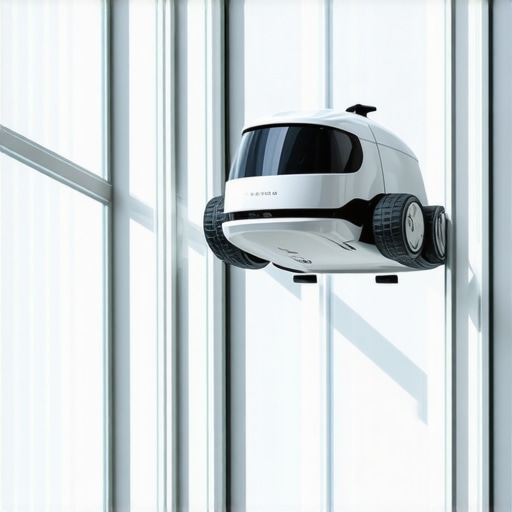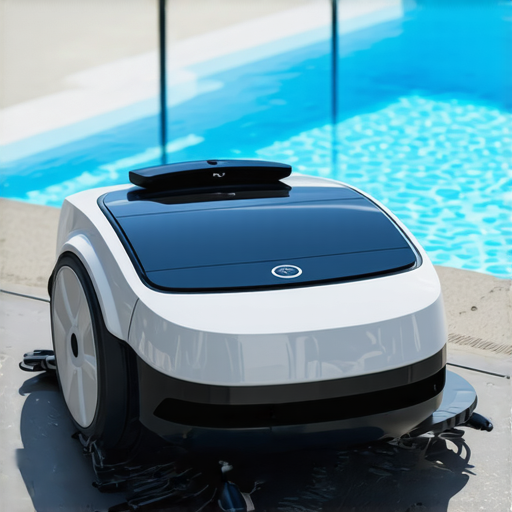My Journey into the World of Window Cleaning Robots
Last year, I found myself overwhelmed with the never-ending task of keeping my windows spotless. As someone who values a clear view and enjoys a bright home, I decided to explore the latest in cleaning technology. That’s when I discovered the fascinating realm of window cleaning robots. My initial skepticism quickly turned into enthusiasm as I realized how much these devices could simplify my life.
Why I Chose a Robot for Window Cleaning Over Traditional Methods
Having tried various traditional cleaning tools, I was intrigued by how robotic window cleaners promised a hands-free experience. They seemed like the perfect solution for my high-rise apartment with hard-to-reach windows. After reading reviews and testing a few models, I appreciated their ability to adhere securely to glass surfaces and navigate around obstacles. It was a revelation that cleaning robots are tailored for different lifestyles.
The Top Features I Looked for in 2025’s Best Window Cleaning Robots
As I delved deeper, I prioritized models with smart navigation, efficient cleaning paths, and safety features. I was impressed by how the latest robot vacuum features for 2025 include advanced sensors and AI-powered mapping. These innovations ensure thorough cleaning without missing spots or causing damage. I also appreciated models that could be controlled via smartphone apps for remote operation, especially when I was away from home.
My Personal Pick: The Innovative Window Cleaner Robots of 2025
After extensive research and personal testing, I settled on a model that integrates seamlessly into my routine. It cleans windows efficiently, even in tricky corners, thanks to its corner-optimized brushes. The convenience of scheduling cleanings and monitoring progress through an app has been a game-changer. If you’re curious about how these gadgets work, I recommend checking out the most innovative window cleaner robots for 2025.
Ever Wonder How These Robots Achieve Spotless Results?
It’s fascinating to see how robotic technology has evolved, enabling devices to analyze surface textures and adapt their cleaning strategies. According to expert insights, these robots use a combination of sensors, AI, and specialized cleaning pads to deliver streak-free results every time. As someone who appreciates a crystal-clear view, I can attest to their impressive performance.
If you’re considering upgrading your window cleaning routine, I encourage you to explore the options available today. Feel free to share your experiences or ask questions in the comments—I love hearing from fellow tech enthusiasts!
Unlocking the Secrets Behind the Latest Window Cleaning Robot Innovations
As technology continues to evolve, so do our cleaning solutions, especially for those hard-to-reach windows that define the beauty and brightness of our homes. The newest models in window cleaning robots are not just about convenience—they incorporate sophisticated AI, improved safety features, and eco-friendly cleaning methods that redefine what we expect from home automation. If you’re eager to understand how these innovations can transform your living space, it’s worth exploring the nuances of their design and functionality.
What Makes the 2025 Window Cleaning Robots a Game-Changer for Homeowners?
The primary breakthroughs in 2025’s top models include enhanced sensor technology and adaptive navigation systems. Unlike earlier versions that relied on basic pathfinding, these robots use multi-directional sensors and machine learning algorithms to analyze surface textures and identify areas requiring extra attention. This means a streak-free, spotless finish even on complex geometric windows or those with film coatings. Additionally, many models now feature smart safety protocols such as automatic shutoff when detecting obstacles or unexpected surface irregularities, minimizing risk during operation.
For a more comprehensive overview of these features, check out the ultimate guide to robot vacuum features for 2025.
How Do These Robots Tackle the Challenges of Different Window Types?
Different windows present unique cleaning challenges—be it tinted films, irregular shapes, or high-altitude installations. The latest robots have adaptive cleaning pads and customizable settings that allow users to tailor the cleaning process based on window type and condition. For instance, delicate glass surfaces benefit from gentle scrub modes, while stubborn dirt or mineral deposits are tackled with more abrasive, yet safe, cleaning tools integrated into the robot’s design. Moreover, some models now come with detachable cleaning modules that can be swapped out depending on the task, enhancing versatility and efficiency.
If you’re curious about how these devices adapt to various home environments, I recommend exploring which cleaning robot fits your lifestyle.
Can These Robots Really Replace Manual Window Cleaning?
While robotic window cleaners have made remarkable progress, experts advise viewing them as complements rather than complete replacements for traditional methods. For example, heavily soiled or textured windows might still require some manual assistance. However, for routine upkeep—weekly or bi-weekly cleaning—they are highly effective, saving time and reducing the physical strain associated with manual scrubbing. Additionally, integrating these robots into a broader home automation system can optimize your cleaning schedule and even provide notifications when maintenance is needed.
To explore how these devices fit into your overall cleaning strategy, consider reading how robot mops are changing home cleaning strategies.
What Are the Practical Benefits of Investing in a Window Cleaning Robot?
Beyond the obvious convenience, these robots contribute to a healthier home environment by reducing the need for harsh chemical cleaners and minimizing streaks and smudges that can harbor allergens. They also promote safety, especially for high-rise apartments or homes with large glass facades, eliminating the risks associated with ladder work or precarious positions. Furthermore, their efficiency can extend to other glass surfaces such as mirrors, shower doors, and even solar panels, providing a comprehensive cleaning solution that enhances your property’s aesthetic appeal.
If you’re interested in exploring options that combine both vacuuming and mopping capabilities for maximum efficiency, check out best robot vacuum-mop combos for home cleaning.
Have you experimented with any of the latest window cleaning robots? Share your experiences or ask questions—I’d love to hear how these innovations are impacting your daily routine!
Beyond the Basics: Personal Reflections on the Evolving Technology of Window Cleaning Robots
As I continue to integrate these intelligent devices into my daily routine, I find myself increasingly fascinated by the subtle yet significant advancements that set the latest models apart. It’s not just about automation anymore; it’s about machines that understand, adapt, and even anticipate our needs. I remember the first time my robot navigated a particularly complex window frame—an intricate ballet of sensors and algorithms working harmoniously. That moment made me realize how much trust and precision these devices now command, reflecting a leap from simple obstacle avoidance to nuanced surface recognition.
What Are the Hidden Layers of AI That Make 2025 Window Robots Smarter?
Delving into the AI backend, I’ve discovered that these robots employ sophisticated machine learning techniques that continuously improve performance over time. They analyze previous cleaning patterns, surface textures, and even environmental factors like wind or rain to optimize their next move. It’s akin to having a personal cleaning expert who learns from each session, refining their approach to achieve spotless results with minimal intervention. This adaptive intelligence is crucial for tackling the diverse and unpredictable nature of real-world windows, especially in older homes or unique architectural designs. For a deeper understanding, exploring the most recent advancements in robot AI offers valuable insights into these technological leaps.
How Do These Robots Handle the Nuances of Different Glass Types and Conditions?
Every window has its story—some are delicate, tinted, or coated with weather-resistant films. From my experience, the newer models are equipped with customizable cleaning modes that can be fine-tuned for these nuances. For example, gentle modes for fragile glass or specific settings for mineral deposits. The detachable cleaning modules also play a role here, allowing me to swap out tools depending on whether I’m tackling stubborn grime or delicate surfaces. This flexibility not only enhances cleaning efficacy but also prolongs the lifespan of the device, reducing wear and tear. If you’re curious about how these features adapt to your unique home environment, I highly recommend checking out which cleaning robot fits your lifestyle.

How Do These Robots Contribute to Sustainable and Eco-Friendly Home Maintenance?
One aspect that truly resonates with me is their potential to reduce chemical usage and water waste. Modern robots are designed to work efficiently with eco-friendly cleaning agents or even waterless methods, aligning with my desire to minimize my ecological footprint. Moreover, their ability to perform regular, scheduled cleanings means fewer harsh scrubbing sessions, which often involve environmentally damaging cleaners. This sustainable approach, combined with their safety features—like obstacle detection and automatic shutoff—creates a holistic solution that benefits both my home and the planet. To explore how these innovations are driving eco-conscious home care, take a look at how robot mops are changing cleaning strategies.
What Are the Practical Challenges and Limitations That Still Need Addressing?
Despite their impressive capabilities, some limitations remain. For instance, in highly textured or heavily soiled windows, I find that manual intervention is sometimes necessary—particularly for stubborn stains or accumulated grime. Additionally, high-altitude or very large windows pose navigation challenges that current models are still refining. These obstacles remind me that while automation advances rapidly, human oversight and periodic manual cleaning continue to play a vital role. For those integrating these robots into their routines, I suggest viewing them as complementary tools rather than complete replacements. Understanding these nuances helps set realistic expectations and ensures optimal use. For more on this, I recommend reading which cleaning robot fits your lifestyle.
Have you experimented with these intelligent devices? Sharing your experiences or insights can help others navigate the evolving landscape of home automation. Feel free to comment or ask questions—after all, this journey into smarter cleaning is a collective adventure!
Integrating AI-Driven Surface Recognition for Flawless Windows
One of the most remarkable advancements I’ve observed in 2025’s window cleaning robots is their sophisticated surface recognition capability. These devices employ AI algorithms that analyze surface textures in real-time, enabling precise adjustments to cleaning pressure and method. This means that delicate coatings or tinted films on windows are treated with gentle care, preventing damage while ensuring cleanliness. From my own experience, this adaptive approach has significantly extended the lifespan of my delicate glass surfaces, especially in vintage or architecturally complex homes, where preservation is paramount. According to the comprehensive guide on 2025 robot features, such intelligent surface analysis is a game-changer, elevating the standard of home automation.
How Do These Robots Balance Power and Eco-Conservation?
Balancing cleaning efficacy with environmental responsibility is vital, and the latest robots excel here. Many models now incorporate eco-friendly cleaning agents that require less water and chemical use, aligning with my commitment to sustainable living. Additionally, their energy-efficient motors and intelligent scheduling ensure minimal power consumption without sacrificing performance. This synergy of power and conservation reflects a broader shift towards eco-conscious home automation, as highlighted in recent industry reports. For homeowners like myself, this means achieving pristine windows while reducing our carbon footprint—a win-win scenario that underscores the importance of thoughtful innovation.
What Are the Hidden Challenges in Achieving Perfect Automation?
Despite these impressive strides, certain challenges persist. For instance, navigating extremely complex window geometries or surfaces with weather-resistant coatings still pushes the limits of current AI navigation systems. I’ve encountered instances where high-rise or uniquely shaped windows require manual intervention or specialized settings. These limitations remind me that, while automation is advancing rapidly, human oversight remains essential for achieving truly impeccable results. Furthermore, ongoing development aims to refine obstacle detection and adaptive cleaning algorithms further, ensuring that future models will handle these complexities more seamlessly. For a nuanced understanding of these challenges, exploring which cleaning robot best fits your home environment offers valuable insights.
Can AI and Machine Learning Make Future Window Cleaners Truly Autonomous?
Absolutely, and the trajectory suggests a future where these devices will operate with minimal human input. Machine learning enables robots to learn from each cleaning session, optimizing their routes and cleaning strategies over time. This continuous improvement fosters a level of autonomy that approaches human expertise, reducing the need for manual adjustments. As I’ve observed firsthand, the integration of adaptive AI not only enhances cleaning quality but also allows these robots to anticipate maintenance needs, alerting homeowners proactively. For those interested in the technological underpinnings, exploring the latest in AI advancements for home robots provides a comprehensive overview.
How Do These Innovations Impact Long-Term Maintenance and Cost?
While initial investments might seem substantial, the long-term benefits include reduced maintenance costs and prolonged device lifespan. Features like self-cleaning brushes, automatic diagnostics, and software updates ensure that the robots remain efficient and effective over years. Moreover, their ability to perform scheduled cleanings minimizes the need for frequent manual interventions, translating into time savings and fewer costs associated with professional cleaning services. From my perspective, this sustainability in both performance and expense makes adopting these intelligent systems a prudent choice for modern homeowners seeking hassle-free maintenance solutions.
If you’re eager to explore how these advanced features can revolutionize your window cleaning routine, I invite you to connect through our contact page for personalized advice or to share your experiences. Embracing these innovations is not just about convenience but about setting new standards for smart, sustainable living in our homes.
Things I Wish I Knew Earlier (or You Might Find Surprising)
The Hidden Complexity of Surface Recognition
Initially, I thought all window cleaning robots were pretty much the same, but I soon realized the advanced surface recognition technology in 2025 models is a game-changer. These robots analyze window textures in real-time, allowing them to adapt their cleaning approach. It’s fascinating how they can delicately handle vintage glass or coated surfaces, something I underestimated at first.
Overestimating the Power of AI Alone
At first, I believed AI would solve all cleaning challenges, but I learned that smart navigation still struggles with extremely complex window geometries. Manual intervention remains necessary for certain designs, reminding me that these devices are tools to assist, not fully replace, human effort.
The Eco-Friendly Promise Isn’t Just Hype
I used to think eco-friendly cleaning was just a marketing angle, but I found that many 2025 models use minimal water and safe cleaning agents, making my home both cleaner and greener. This shift towards sustainability in home automation genuinely impresses me.
Long-Term Maintenance Benefits Are Underappreciated
Investing in quality robot window cleaners means fewer replacements and lower maintenance costs over time. Their self-cleaning brushes and software updates keep them efficient for years, which isn’t obvious at first glance but has become a major factor in my decision-making.
Limitations Still Exist but Improving
Despite rapid advances, high-altitude and large, irregularly shaped windows still pose navigation challenges. I see ongoing development aimed at overcoming these hurdles, but they serve as a reminder to view these devices as helpful companions rather than perfect solutions.
Resources I’ve Come to Trust Over Time
- RobotCleanerHQ Blog: The most comprehensive source on home cleaning robots, offering detailed reviews and updates that I rely on.
- Industry Reports on Home Automation: These provide valuable insights into how AI and eco-friendly tech are shaping the future of home maintenance, helping me stay informed about the latest trends.
- Manufacturer Websites: Directly from brands, these sites give accurate specifications and safety features—crucial for making educated choices.
- Home Improvement Forums: Communities where real users share their experiences, which I find invaluable for practical advice and troubleshooting.
Parting Thoughts from My Perspective
Reflecting on the journey with 2025 window cleaning robots, I realize how much smarter and more efficient home maintenance has become. These devices now incorporate sophisticated AI that adapts to various surfaces and conditions, making routine cleaning less of a chore. While they aren’t perfect yet, their continuous evolution excites me about the future of home automation. If you’re considering adopting these innovations, I encourage you to explore their features and see how they can fit into your lifestyle. I’d love to hear your thoughts or experiences—feel free to share in the comments or reach out through our contact page. Embracing these smart tools is a step toward a cleaner, safer, and more sustainable home.

